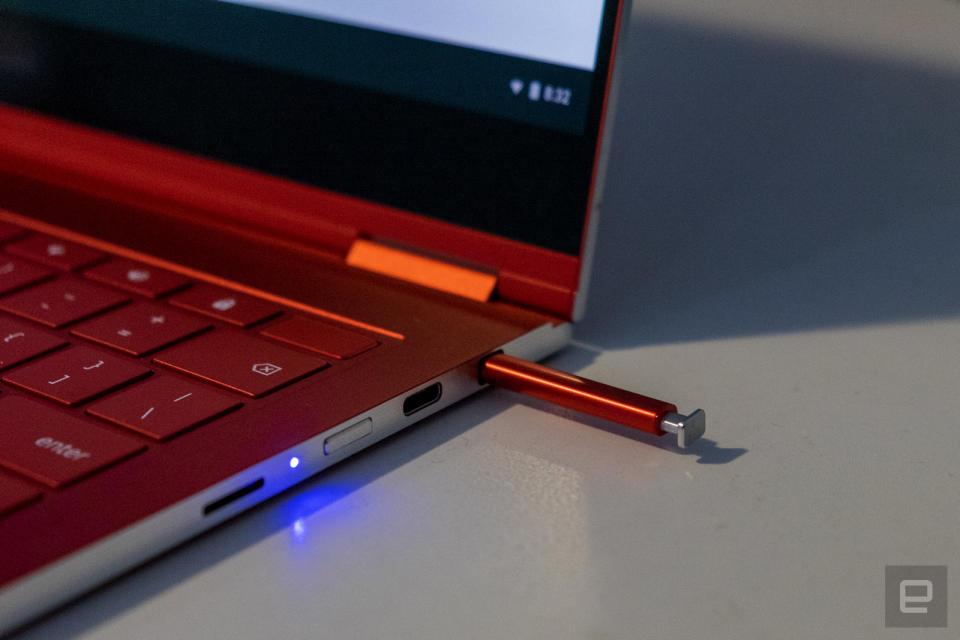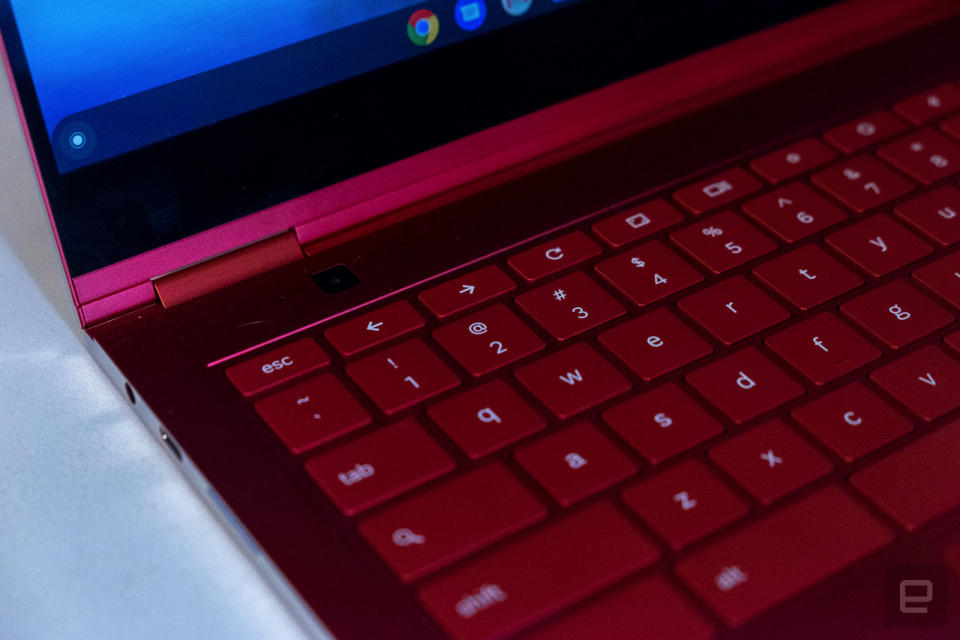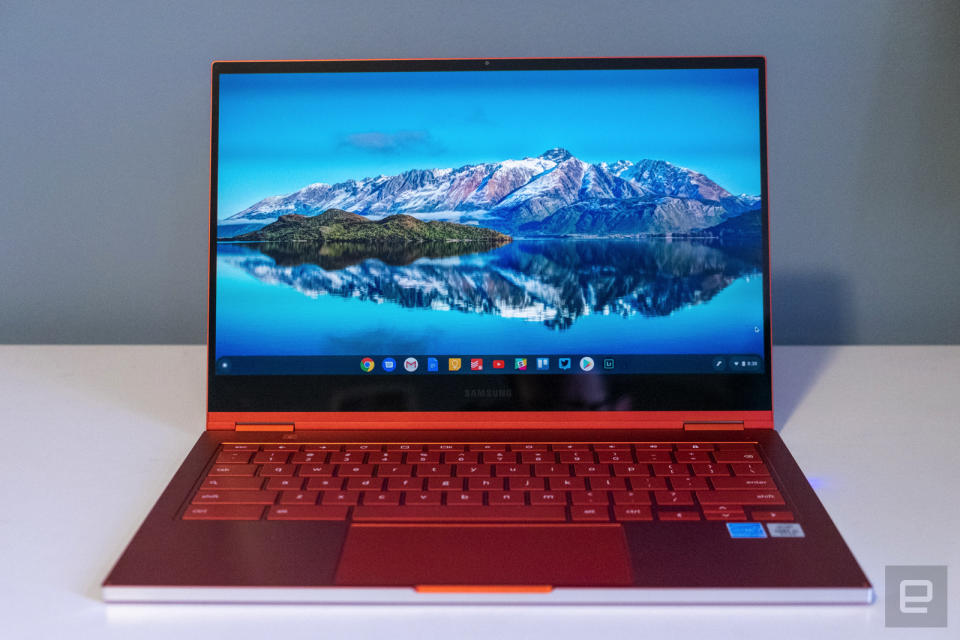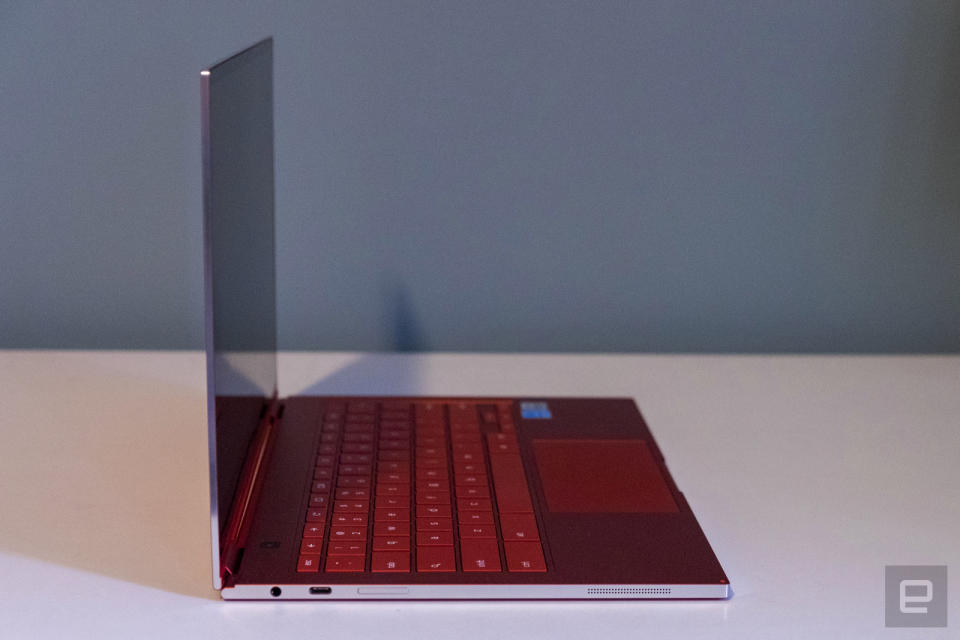Samsung Galaxy Chromebook review: Great, until the battery runs out
That 4K screen comes at a major cost.
Google has been selling expensive, high-end Chromebooks for years now. But last year, the company changed tactics. The Pixelbook Go was “only” $650, a far cry from the $1,000-plus price Google asked for its previous Chromebooks. Google cut a few corners to hit that price point, but the Pixelbook Go was easy to recommend as a Chromebook that almost anyone could use as a full-time computer. But if you were one of the few out there who has been clamoring for a follow-up to 2017’s Pixelbook, the Go didn’t quite meet the mark.
Enter Samsung. At CES earlier this year, the company showed off the stunning Galaxy Chromebook, a computer that really does feel like a successor to the original Pixelbook. Amenities include a gorgeous 4K touchscreen, a stowable pen, lots of storage and processing power, and an sleek, all-metal enclosure. And you can’t miss it in that bold red color. On paper, it’s a capable and well-designed computer, easily one of the best Chromebooks on the market. But at $999, we’re asking a familiar question: should anyone spend that much money on a Chromebook?
Hardware

There are no two ways around it: The Galaxy Chromebook is a head-turner. The metallic red pops like few other laptop colors I’ve seen over the years. (You can also get the laptop in a more pedestrian gray, if that’s your jam.) It’s not just the color, though: The Galaxy Chromebook’s silver metal edge is squared off, not contoured like most laptops. It’s near-identical to the design of the original Pixelbook, and it helps the computer stand out when it’s closed.
The Galaxy Chromebook has an intriguing set of ports and features. For starters you’ll notice two USB-C connections, one on each side. Samsung also included a microSD card slot -- I would have preferred a standard SD slot, but it’s better than nothing. Since the Galaxy Chromebook has a 360-degree hinge, there are two small speakers on the side for when you have the laptop flipped into tablet mode. The power button is also on the side along with a volume rocker. Finally, there’s a slot for the included stylus, which feels quite similar to those included with Samsung’s Chromebook Plus and Chromebook Pro from 2017.
The Galaxy Chromebook’s tiny side speakers had me a bit worried about audio quality, but I came away pleasantly surprised. There’s a third larger speaker underneath the laptop that fires into your lap or a desk, and the combination of that and the smaller speakers do a good job for music playback and YouTube videos. They’re not as good as the excellent speakers on the MacBook Pro I use every day, with a bit less overall volume and bass response. They’re also a little bit tinny, as many laptop speakers are, but they’re definitely better than I expected.
The Galaxy Chromebook’s 360-degree hinge lets you flip it around and use it as a tablet in a pinch, or prop it up for watching videos. I’ve never found 360-degree modes very useful. Even though this computer is only 9.9mm thin and weighs about 2.3 pounds, that’s still a lot bigger and heavier than my iPad. But, it makes for one very compact laptop. It’s ever-so-slightly slimmer than the original Pixelbook, and much thinner than the Pixelbook Go.
While I don’t really care about being able to flip the screen around, the Galaxy Chromebook excels as a more traditional laptop. For starters, Samsung absolutely nailed the keyboard here. It’s quiet and comfortable, possibly even more so than the Pixelbook Go. It’s quickly become one of my favorite computers to type on. It’s the same keyboard layout you’ll find on most Chromebooks, with one notable exception. There’s a fingerprint reader, right where Touch ID sits on MacBooks. Setting it up was easy and, once I figured out how it wanted me to position my finger, it was a reliable and fast way to sign in.

The trackpad isn’t quite as inspired. It’s smooth and responsive, but just a little bit too small, particularly in the vertical direction. There’s a good amount of space between the edge of the chassis and the top of the keyboard, so I wish Samsung had pushed things up a bit to make for a bigger touchpad.
But if that were the case, there might not be room for the camera embedded in the keyboard deck. Don’t worry, it’s not for video chat. Samsung says it’s primarily there for taking pictures of a whiteboard in class, for example, or for scanning documents. That requires flipping the screen around so you’re in tablet mode, which makes sense -- but Chrome OS has never handled quick switching between those two modes, and the first time I tried it, all the apps I was using crashed. It’s not a feature I rely on, but it’s there if you need it.
When looking at the Galaxy Chromebook’s screen, the first thing you’ll probably think is “Wow, those bezels are thin!” It’s true -- Samsung says they’re 3.9mm wide, though the top border is slightly thicker to make room for the video chat camera. The second thing you’ll probably think is “Wow, that bottom bezel is huge.” And it is -- over an inch thick, in fact. Taken as a whole, the three tiny bezels and one big one doesn’t look bad, per se, but it really makes me wish the screen extended further down.
The Galaxy Chromebook may sport an impressive 4K resolution, but the 16:9 aspect ratio just feels too limiting to me these days. Even Apple’s 16:10 laptops feel significantly more comfortable, to say nothing of the taller 3:2 ratio you’ll find in a smattering of computers these days, like Microsoft’s Surface Laptop and Google’s own Pixelbook.
In happier news, this panel looks excellent. It’s the first OLED display on a Chromebook, and the high contrast, bright colors and deep blacks were all pleasing to my eyes. The 4K resolution makes everything extremely sharp, from websites to photos and movies. Going back to my MacBook Pro was a bit of a drag, although I will say that Samsung’s display almost exaggerates colors beyond their natural hues, a common complaint with the company’s smartphone displays.
The Galaxy Chromebook also has a feature called Ambient EQ, which works like True Tone on Apple displays. That is to say, it matches the color temperature of the screen to your surroundings, a first for a Chromebook. While the idea is the same as True Tone, Ambient EQ is definitely more aggressive in terms of the adjustments it makes -- the color temperature is very warm and yellow even in rooms where I thought I had pretty neutral light. Naturally, you can turn this feature off, something I’d recommend whenever working with photos or watching a video.
My main issue with the display Samsung chose is the same I’ve had with multiple recent Chromebooks: the 16:9 aspect ratio. For a while, a bunch of Chromebooks were using taller screens that displayed more vertical content (something you’ll also find on Microsoft’s Surface hardware), but it seems the tide has turned back to the default 16:9 ratio. It’s good for watching video or splitting the screen between two apps, but I pretty much always found myself wishing I could see more of a document, web page, or chat I was in.

In use
For now, Samsung is only selling one configuration of the Galaxy Chromebook, which includes a 10th-generation Intel Core i5 processor, 8GB of RAM and 256GB storage. That’s plenty to run just about everything I need in Chrome OS without an issue. That includes a few browser windows with multiple tabs in each, plus Chrome apps for Google Keep, Todoist, Trello, YouTube Music, Tweetdeck, Slack, Hangouts and Telegram. For those basic needs, the Galaxy Chromebook had more than enough power; I never felt like I was pushing things too far when opening more and more tabs, and I also didn’t notice any hiccups in music playback.
Since the Galaxy Chromebook can flip around and has a built-in pen, I tried a handful of different sketching and note-taking apps. I have no fine artistry skills, but I still could get a sense of how the pen worked. The good news is that note-taking in Google Keep is near lag-free, which hasn’t always been the case. Google’s simple, built-in Canvas Chrome app also performs quite well.
As for third-party apps, MyScript Nebo also had low lag and was able to turn my handwritten notes into text I could copy and share anywhere. Other apps, like Infinite Painter and Adobe Sketch, were laggy enough that I couldn’t imagine anyone using them to do serious work.
As with most other Chromebooks I’ve used, I still feel features like a 360-degree hinge and a pen are nice to have, at best -- but hardly essential. My main concern is how the Galaxy Chromebook holds up as a laptop. Its powerful hardware and excellent keyboard ensured it excelled in that department. As I mentioned earlier it’s already one of my favorite computers to type on, despite the lack of vertical screen real estate.
Unfortunately, there is one massive problem: The Galaxy Chromebook’s battery life is unacceptable. In a test of my basic daily routine, I failed to clear the four-hour mark multiple times. The best I did was three hours and 52 minutes of use before the laptop shut down. When looping an HD movie stored on the laptop’s drive, I got five hours and 11 minutes before the battery died. The clear cause of this is the notoriously power-hungry 4K display, but that doesn’t make it OK. If Samsung was hell-bent on that high-resolution display, it could have made the Galaxy Chromebook a little thicker with a bigger battery. Or it could have kept the slim profile but went with a lower resolution. But doing both means that this will not be a reliable workhorse for people who need to spend a lot of time away from a charger.
The competition

The obvious competitor for the Galaxy Chromebook is Google’s own Pixelbook. They’re both priced at $999 and have similarly thin and light bodies as well as a 360-degree hinge. The Pixelbook has a taller, 3:2 aspect ratio screen which I greatly prefer -- but it also has huge bezels that looked out of place in 2017, let alone now. Speaking of 2017, yes, the Pixelbook is about two and a half years old now. As such, it’s running a 7th-generation Intel Core i5 processor in its default configuration, not the 10th-generation chip found in the Galaxy Chromebook. The Pixelbook still runs well, but it’s hard to swallow the idea of spending that much money on a machine with an aging processor.
Another good point of comparison is Google’s Pixelbook Go, released in late 2019. It’s significantly cheaper than the Galaxy Chromebook, starting at $649. But that only gets you an Intel m3 processor and 64GB of storage. The closer comparison is the $849 model which steps up to an 8th-generation Core i5 processor and 128GB of storage. The Galaxy Chromebook still wins on processor and storage, and for that money you also get a more refined design, the 360-degree hinge, built-in pen and a 4K display. However, the Pixelbook Go has excellent battery life, something I cannot say about Samsung’s latest.
Another new entry to the premium Chromebook space is coming from ASUS in the form of the Chromebook Flip C436. I haven’t had a chance to try that laptop yet, although ASUS has made some of the best Chromebooks on the market in years past. The Flip C436 will also feature Intel’s 10th-generation processors, so it should make for a good comparison to what Samsung features in the Galaxy Chromebook. ASUS initially said the Flip C436 would be available by the end of March -- they didn’t make that date, but we should know more about it soon.

Wrap-up
Samsung’s latest Chromebook does many things right. It’s a delight to type on, it impresses with a very compact design, and the screen looks brilliant. In many ways, it’s a clear successor to Google’s aging Pixelbook. But for $999, it’s almost impossible to forgive the poor battery life, especially given that there are other options for powerful Chromebooks out there. Not to mention that you could get Apple’s just-updated MacBook Air or Microsoft’s Surface Laptop 3 for that price. I can accept that a laptop with a 4K display won’t last 10 hours. But in 2020, I can’t recommend one that doesn’t even last four.
